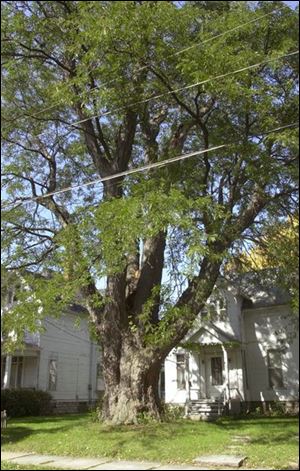
Some plants have it made in the shade
8/10/2005Being in the dark isn't necessarily a bad thing. During the dog days of August, that shady corner is valuable property.
A garden with four hours or less of sunlight is usually considered shady. It can be tough to grow sun-loving plants or turf there, so why fight it?
Pick some plants that like the shade and groundcovers that can prosper in low light.
If you are short on shade, make your own. Japanese maple, shagbark hickory, and thornless honeylocust will cast lacy shadows on the ground. Crape myrtle, magnolia, crabapple, willow oak, and sourwood will produce some blossoms and fuzzy buds in addition to a bit of shade.

Honeylocust tree
Larger perennial shrubs can also create some shade. Butterfly bush, smoke bush, bigleaf hydrangea, doublefile viburnum, pagoda dogwood, and Chinese fringe flower can make a good start.
Backyard structures like a trellis, fence, or pergola don't need to be empty. It may take a while to get wisteria established, but patience will pay off. Chain-link fences can disappear behind a curtain of silver lace vine. This hardy perennial grows quickly and blossoms with tiny white flowers and interesting foliage.
Planting morning glories at the base of a fence, trellis, or pergola can create some shade in just a few short weeks. Annual and perennial sweet pea will provide shade, coverage, and fragrance from the multicolored blossoms. Standbys like Virginia creeper, nasturtium, and grapevine can also grow on a structure in the yard.
A shade garden with a Victorian feel might include oakleaf hydrangea, soft shield fern, flowering tobacco, white impatiens, ivy, and variegated Solomon's seal.
Plant shade lovers with a contemporary or Japanese theme like Stewartson rhododendron, Jane Platt fothergilla, Wester Flisk stinking hellebore, Japanese aralia, Japanese hydrangea vine, black mondo grass, autumn fern, toad lily, and red laceleaf maple tree as a focal point.
A forest pansy Eastern redbud tree would make a great focal point for a native shade garden. Accents of Canadian columbine, goat's beard, wild ginger, hot lips turtle head, crested iris, cardinal flower, and great blue lobelia will complete the low-light look.
When you plant in the shade, you have to find some room to plant around big tree roots and thick roots from other established flora. Put the groundcovers close to tree trunks and use plants with different heights and textures in tight corners. Because plants grow slower in the shade, buy larger ones to fill the space.
If you want to make a new planting area and do it fast, mow the open area at the lowest setting on your mower. Cover it with five to 10 layers of newspaper to keep the weeds out, then cover it with eight to 12 inches of soil. The newspaper will decompose in about six months and you will have more plants to admire while you are sitting in the shade.